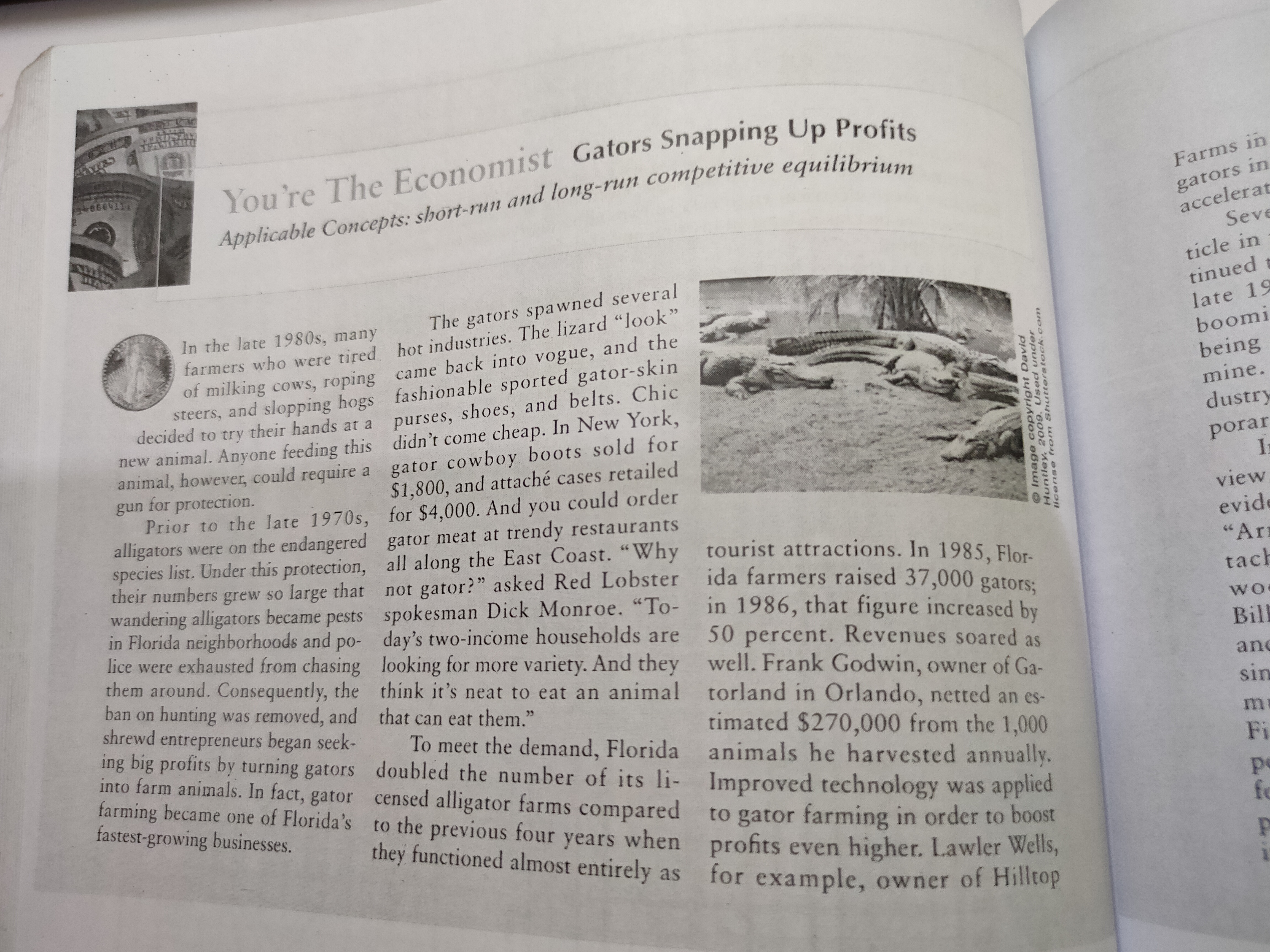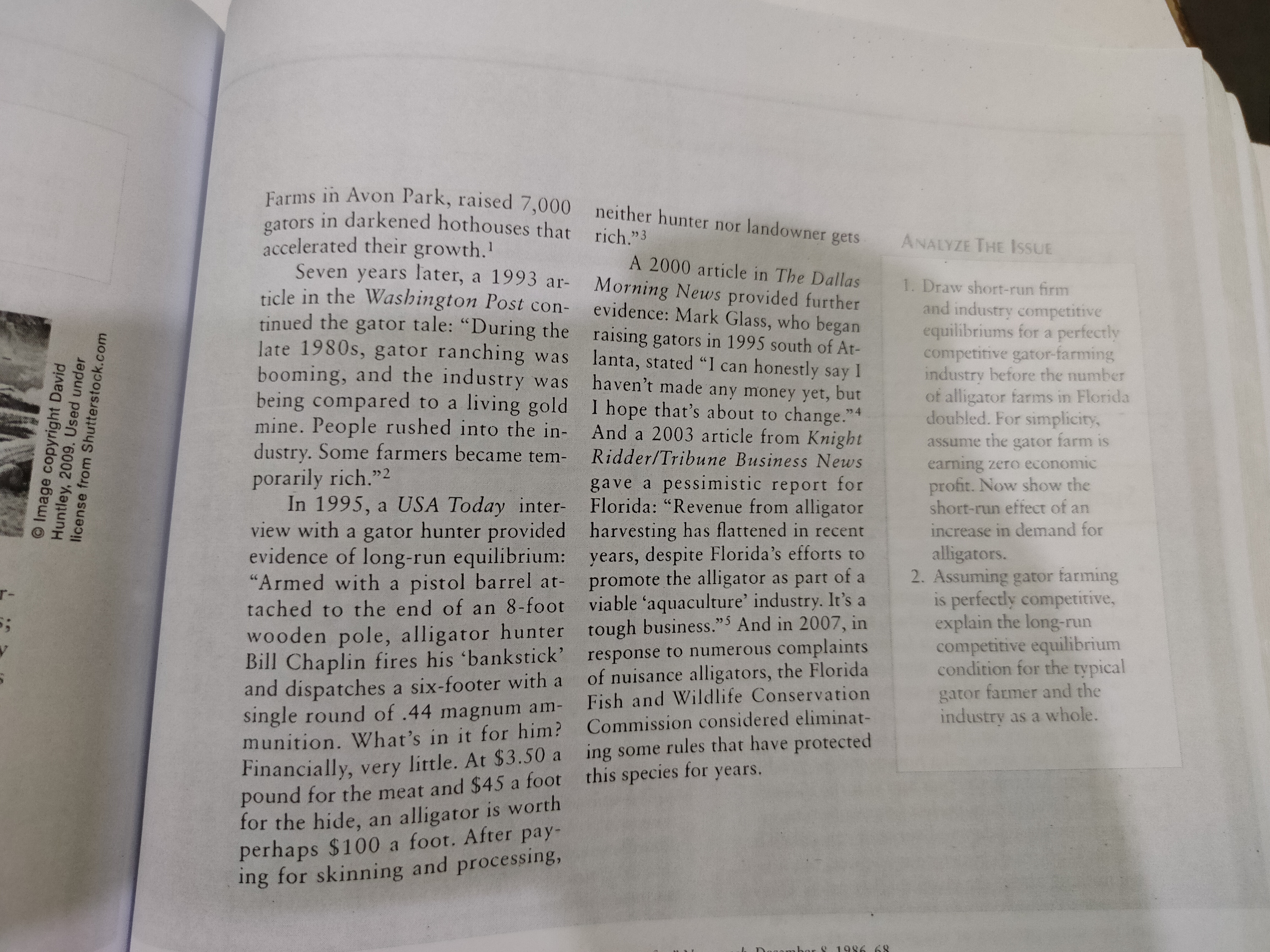
ENGR.ECONOMIC ANALYSIS
14th Edition
ISBN: 9780190931919
Author: NEWNAN
Publisher: Oxford University Press
expand_more
expand_more
format_list_bulleted
Question
What could be the answer for second question? Can i get some idea so that i could futher write in detail please?

Transcribed Image Text:You're The Economist Gators Snapping Up Profits
Applicable Concepts: short-run and long-run competitive equilibrium
Farms in
gators in
accelerat
Seve
ticle in
tinued t
late 19
The gators spawned several
In the late 1980s, many
farmers who were tired hot industries. The lizard "look"
of milking cows, roping came back into vogue, and the
boomi
steers, and slopping hogs fashionable sported gator-skin
decided to try their hands at a
being
mine.
purses, shoes, and belts. Chic
new animal. Anyone feeding this didn't come cheap. In New York,
animal, however, could require a
for protection.
Prior to the late 1970s, for $4,000. And you could order
alligators were on the endangered gator meat at trendy restaurants
species list. Under this protection, all along the East Coast. "Why tourist attractions. In 1985 Ele.
their numbers grew so large that not gator?" asked Red Lobster ida farmers raised 37.000 gater
wandering alligators became pests spokesman Dick Monroe. "To-
in Florida neighborhoods and po- day's two-income households are
lice were exhausted from chasing looking for more variety. And they well. Frank Godwin, owner of Ga-
them around. Consequently, the think it's neat to eat an animal torland in Orlando, netted an es-
ban on hunting was removed, and that can eat them."
shrewd entrepreneurs began seek-
ing big profits by turning gators doubled the number of its li- Improved technology was applied
into farm animals. In fact, gator censed alligator farms compared
farming became one of Florida's to the previous four when
fastest-growing businesses.
dustry
gator cowboy boots sold for
$1,800, and attaché cases retailed
porar
In
gun
view
evide
"Ar
tach
in 1986, that figure increased by
50 percent. Revenues soared as
WO
Bill
and
sin
timated $270,000 from the 1,000
To meet the demand, Florida animals he harvested annually.
mi
Fi
pe
fo
to gator farming in order to boost
profits even higher. Lawler Wells,
for example, owner of Hilltop
years
they functioned almost entirely as
©Image copyright David
Huntley, 2009. Used under
license trom Shutterstock.com
E డడి

Transcribed Image Text:Farms in Avon Park, raised 7,000 neither hunter nor landowner gets
gators in darkened hothouses that
accelerated their growth.'
Seven years later, a 1993 ar-
ticle in the Washington Post con-
tinued the gator tale: "During the raising gators in 1995 south of At-
late 1980s, gator ranching was
booming, and the industry was
being compared to a living gold I hope that's about to change."4
mine. People rushed into the in-
dustry. Some farmers became tem-
rich."3
ANALYZE THE IssUE
A 2000 article in The Dallas
1. Draw short-run firm
and industry competitive
equilibriums for a perfectly
competitive gator-farming
industry before the number
of alligator farms in Florida
doubled. For simplicity,
Morning News provided further
evidence: Mark Glass, who began
lanta, stated "I can honestly say I
haven't made any money yet, but
And a 2003 article from Knight
assume the gator farm is
earning zero economic
profit. Now show the
short-run effect of an
Ridder/Tribune Business News
porarily rich."2
In 1995, a USA Today inter-
view with a gator hunter provided harvesting has flattened in recent
evidence of long-run equilibrium: years, despite Florida's efforts to
"Armed with a pistol barrel at-
tached to the end of an 8-foot viable 'aquaculture' industry. It's a
wooden pole, alligator hunter tough business."5 And in 2007, in
Bill Chaplin fires his 'bankstick' response to numerous complaints
and dispatches a six-footer with a
single round of .44 magnum am-
munition. What's in it for him? Commission considered eliminat-
Financially, very little. At $3.50 a ing some rules that have protected
pound for the meat and $45 a foot this species for years.
for the hide, an alligator is worth
perhaps $100 a foot. After pay-
ing for skinning and processing,
gave a pessimistic report for
Florida: "Revenue from alligator
increase in demand for
alligators.
2. Assuming gator farming
is perfectly competitive,
explain the long-run
competitive equilibrium
condition for the typical
promote the alligator as part of a
r-
of nuisance alligators, the Florida
Fish and Wildlife Conservation
gator farmer and the
industry as a whole.
or 8 1986
68
O Image copyright David
Huntley, 2009. Used under
license from Shutterstock.com
Expert Solution
This question has been solved!
Explore an expertly crafted, step-by-step solution for a thorough understanding of key concepts.
This is a popular solution
Trending nowThis is a popular solution!
Step by stepSolved in 2 steps with 2 images

Knowledge Booster
Learn more about
Need a deep-dive on the concept behind this application? Look no further. Learn more about this topic, economics and related others by exploring similar questions and additional content below.Similar questions
Recommended textbooks for you

 Principles of Economics (12th Edition)EconomicsISBN:9780134078779Author:Karl E. Case, Ray C. Fair, Sharon E. OsterPublisher:PEARSON
Principles of Economics (12th Edition)EconomicsISBN:9780134078779Author:Karl E. Case, Ray C. Fair, Sharon E. OsterPublisher:PEARSON Engineering Economy (17th Edition)EconomicsISBN:9780134870069Author:William G. Sullivan, Elin M. Wicks, C. Patrick KoellingPublisher:PEARSON
Engineering Economy (17th Edition)EconomicsISBN:9780134870069Author:William G. Sullivan, Elin M. Wicks, C. Patrick KoellingPublisher:PEARSON Principles of Economics (MindTap Course List)EconomicsISBN:9781305585126Author:N. Gregory MankiwPublisher:Cengage Learning
Principles of Economics (MindTap Course List)EconomicsISBN:9781305585126Author:N. Gregory MankiwPublisher:Cengage Learning Managerial Economics: A Problem Solving ApproachEconomicsISBN:9781337106665Author:Luke M. Froeb, Brian T. McCann, Michael R. Ward, Mike ShorPublisher:Cengage Learning
Managerial Economics: A Problem Solving ApproachEconomicsISBN:9781337106665Author:Luke M. Froeb, Brian T. McCann, Michael R. Ward, Mike ShorPublisher:Cengage Learning Managerial Economics & Business Strategy (Mcgraw-...EconomicsISBN:9781259290619Author:Michael Baye, Jeff PrincePublisher:McGraw-Hill Education
Managerial Economics & Business Strategy (Mcgraw-...EconomicsISBN:9781259290619Author:Michael Baye, Jeff PrincePublisher:McGraw-Hill Education


Principles of Economics (12th Edition)
Economics
ISBN:9780134078779
Author:Karl E. Case, Ray C. Fair, Sharon E. Oster
Publisher:PEARSON

Engineering Economy (17th Edition)
Economics
ISBN:9780134870069
Author:William G. Sullivan, Elin M. Wicks, C. Patrick Koelling
Publisher:PEARSON

Principles of Economics (MindTap Course List)
Economics
ISBN:9781305585126
Author:N. Gregory Mankiw
Publisher:Cengage Learning

Managerial Economics: A Problem Solving Approach
Economics
ISBN:9781337106665
Author:Luke M. Froeb, Brian T. McCann, Michael R. Ward, Mike Shor
Publisher:Cengage Learning

Managerial Economics & Business Strategy (Mcgraw-...
Economics
ISBN:9781259290619
Author:Michael Baye, Jeff Prince
Publisher:McGraw-Hill Education